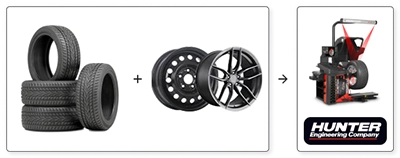How to check if your winter tires are still good in Canada?

When it's time to change winter tires, we often wonder if our tires are still safe, if they can make it through the following season, or if they are already too worn. Tires that are too worn are more likely to be damaged when you drive through a pothole or do not have enough traction to stay on the road.
How do you know if your winter tires are still good? What is the wear limit for a tire to be safe? Are my winter tires too old? Here is some information to help you make the right decision.
Transport Canada states on its website that tires worn to nearly 4 millimeters (5/32") should not be used on snowy roads in Canada.
Tire manufacturers and the law in most Canadian provinces state that your tires must be replaced when the tread depth reaches 4/32" in winter.
Your tires are therefore considered worn and present a safety risk.
According to CAA-Quebec, it is not recommended to drive with tires with a tread depth of less than 4.8 mm (6/32 inch), as winter tires lose their grip on snowy or icy roads.
There are three simple ways to check the condition of your tires
1- Check the tire tread thickness.
When winter tires are at peak performance, they can repel slush and snow, grip ice, brake and corner on slippery roads. However, as the tread depth of your winter tires wears down over the seasons, their performance decreases.
The most reliable way to know the condition of your tires is to use a depth gauge. Insert the rod in 3 or 4 places in the tire grooves.
Press down on the base of the gauge until it is level with the tire's tread. The lowest reading you get is the overall wear of the tire.
If you don't have a depth gauge, a simple way to measure your tires is with a coin.
10 or 25 cents
The easiest way to check the tread on your tire is to use a dime. Insert it into the tread and see what part of the boat's sail you can see. If you can see the top of the Bluenose mast, the tire is worn, and it's time to change it.

If you have a quarter, insert your coin into the tread with the caribou head down.
If you can still see the caribou nose, it's time to change the tire.
The tire manufacturers recommend that you measure the tread thickness every month.
2- Check the date of manufacture of the tires by using the DOT code
DOT is the abbreviation for Department of Transportation (DOT), located on the tire's sidewall. The DOT marking, numbers and letters on the tire let you know where and when the tire was manufactured.
The date of manufacture is the last four digits of the DOT code. The first two digits represent the week of manufacture, and the last two represent the year. For example, if the last four digits of the DOT code are 1022, the tire was manufactured in the tenth week of 2022.
It is impossible to determine precisely how long a tire will last. The life and mileage of a tire depend on a combination of factors, including tire quality, driver habits, climate, road conditions and tire maintenance. But as a general rule, expect a five-year life span.
Most major manufacturers produce their tires overseas, and between production and shipping times, tires often arrive in Canada one to three years after their production date. Because the Canadian market is very seasonal, tires can sit in a warehouse for several months.
However, tires must be replaced after 10 years from the date of manufacture. This is true even if they appear in good condition and have not reached the wear indicator level. Most importantly, remember that this manufacturer's recommendation also applies to spare tires.
3- Inspect each tire individually to identify different types of wear
It's essential to check the condition of your tires by inspecting them one by one to determine if they are still safe to drive on. Your tires may wear if they are mounted on the front or rear. The tread may also wear differently on the right or left side. If this is the case, you may have an alignment problem!
Tire wear is often related to an alignment or pressure problem.
This is the case with irregular wear or wears on a single shoulder. It may be due to misalignment or a sign that some parts of your vehicle are not in good condition. If you notice premature tread wear, the tire may be under-inflated.
If the wear is in the center of the tread, the tire is over-inflated or being driven at excessive speeds.
When you notice visible signs of wear, the tire should be replaced.
Store your tires properly
If you alternate between all-season and winter tires, your unused tires must be stored in a dry, ventilated area away from the elements to protect them.
Temperature extremes affect the aging of rubber. It is recommended to choose a peaceful location, away from direct sunlight, rather than exposing them to temperatures that are too hot or too cold.


